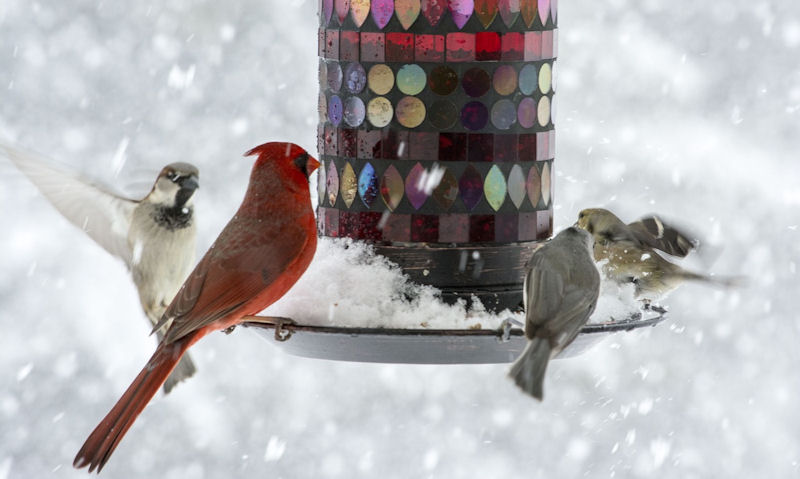How to keep snow off bird feeders
With our wild birds needing to feed more than ever in snow as natural food becomes depleted, its wise to keep bird feeders snow-free to help them survive this time of year.
How to keep snow off all bird feeders would rely on each and every suspended bird feeder, being hung below, and within, a downward squirrel dome. Rather than snow falling on feeders, snow will gradually build up on the top side of the dome instead - with sideways snow prevented with a deep, wider dome.
Come to think about it, I don't think its all that hard to keep snow off hanging bird feeders, because all its takes is to add cover above any suspended feeder.
Really, there is no need to make your own protective cover, like with use of an umbrella, as there's something on the market today that is suited to keeping snow and rain off bird feeders - and that is with use of a hanging-style squirrel baffle.
What is a hanging squirrel baffle actually? Well, its a basic clear plastic downward facing dome, which will allow squirrels to climb on top of it, but prevent rodents getting on the bird feeders which are suspended beneath the dome.
And how does this squirrel baffle help by keeping bird feeders snow-free, well, this dome becomes a second roof to hanging bird feeders.
How you continue to make bird feed accessible in bird feeders would be by allowing snowfall to buildup on the baffle, while each bird feeder hanging beneath it - while directly hooked in the dome - will be free of snow, and even rain.
How to feed birds in snow is essentially keeping bird feed accessible, and as snow covers access points to the food within feeders, you must do all you can to keep it snow-free - with extra effort made on the port wells and food access points.
Attracting birds to bird feeders in snow is easy when they continue to be accessible, but birds are unlikely to return if the bird feed is inaccessible.
And with that, suet cages in particular can be kept snow-free as they're small devices that can hang completely under the dome, while allowing full accessing to songbirds.
Allow snow to pile on a baffle
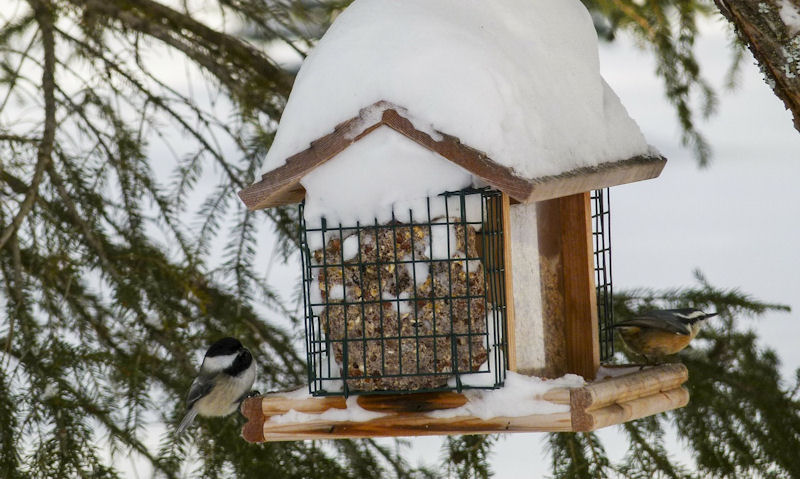
Whether it be keeping pests off bird feeders or all kinds of weather, what it always boils down to, is use of a suspended-style squirrel baffle dome.
It would ideally be a squirrel baffle with no access to the kept dry underside - like where the wire is connected to the baffle on the center-top - but even if there is a tiny gap, it won't be enough to cause snow to build up.
Suspending bird feeders under a corresponding hanging squirrel baffle will allow snow to build up on top of this plastic dome, as oppose to the top of the bird feeder.
With any vertical snowfall, all snow will slowly build up on top of this dome whilst the bird feeder remains snow-free, and continues to be accessible to wild birds.
On the downside, any horizontal snow during blistering storms would see usually one-side of the wire bird feeder in particular, cover in snow and ice.
With bird feeders suspended off a bird feeder pole in the middle of the lawn, there's really no way to keep bird feeders out of windy weather when its purpose is to attract a variety of birds from all directions - and thus it becomes even harder when it snows.
Snow will still hit bird feeders
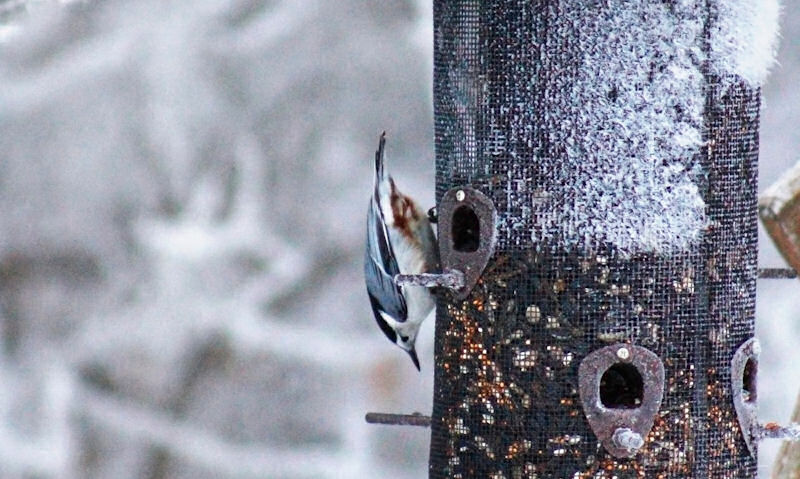
Bearing in mind any type of squirrel baffle that can keep off both snow and rain quite effectively, can only protect bird feeders on its top half only.
You see, we can't really do a lot about sideways wind which will cause the snowfall to cover, probably 50% of the bird feeder, as the snowy storm begins to build up on the side of the feeder, which will probably obstruct access points to the bird feed.
With that to contend with, you may think about using a squirrel baffle-dome that is very deep, where the hanging bird feeder will be suspended even more under the dome.
In addition, you will want to shorten the length of which all bird feeders are hung, which is all done in an effort to push the bird feeders under a wide, deep dome to protect the bird feeders from snow falling at all angles.
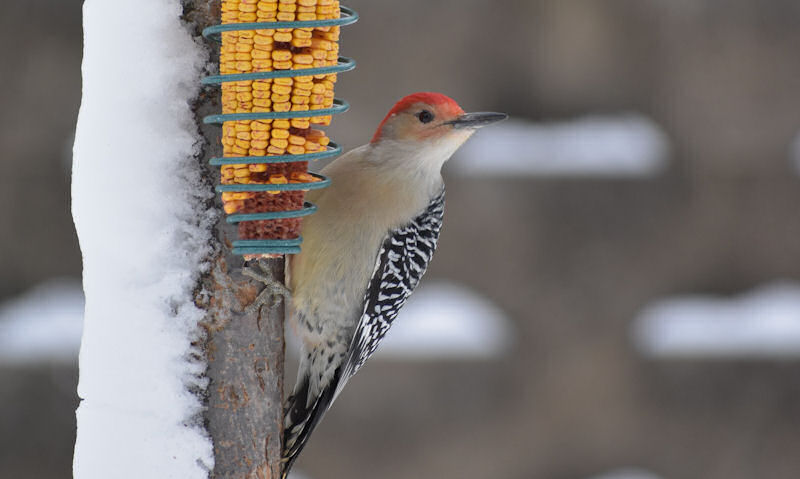
As you'll be continuing to utilize what will probably be seed bird feeders in winter, this type of tubular feeder does result in snow blocking up the port wells.
And as the port wells are positioned closer to the bottom, unfortunately this is where snow will begin to build. Whereas an open peanut or suet cage-type bird feeder would see snow cling on to one side - along with snow freezing up the bird feed that is usually exposed to the elements.
Peanuts and suet should be fed to wild birds in winter especially, and thus must continue to be accessible as its a vital protein source.
Birds really will want to use your bird feeders in winter, thus its vital they continue to be accessible, with snow shaken or brushed off if the squirrel baffle doesn't cut it.
Gradually re-position under shelter
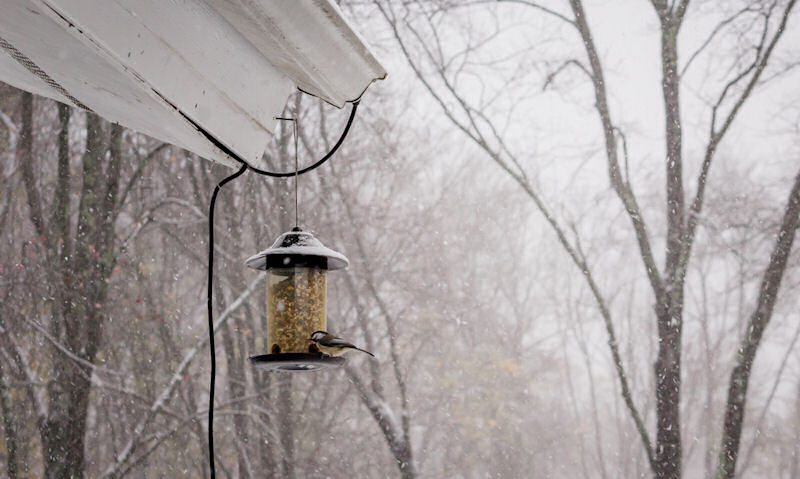
Other than relying on a downward facing squirrel baffle dome that is suspended above all hanging bird feeders in use, you can continue to use baffles for each bird feeder, while thinking about re-positioning the feeder within a sheltered space.
What kind of shelter will be available in your yard really depends on personal circumstances.
Although I will recommend you at least relocate the bird feeder pole - which I assume is currently used to hang all bird feeders on - where it will be pushed closer to a structure in your yard, to prevent sideways snowfall at least.
Bear in mind wild birds can lose sight of a re-positioned bird feeder pole, so it helps to move it gradually, over several days, as to not accidentally obstruct the bird feeders.
Natural vegetation helps to protect bird feeders in snow, and so would anything from the deck and porch cover and railings, plus the garden fence or wall.
To hang a Hummingbird feeder in snow especially, for the Hummers that stick around all year, you will want to hang their nectar-filled feeders under the porch or deck roof - with the nectar not only freezing up, but the port wells do freeze over to.
Best way to attract wild birds to your yard in winter continues to rely on feeders, and the best way to keep bird feed accessible is too continue to hang bird feeders.
Conclusion
How you are going to keep snow off suspended bird feeders in particular, come the winter snow, is with use of a classic suspended-style squirrel baffle.
Great if you already utilize a squirrel baffle to keep squirrels out of bird feed, with the one currently in use fully compatible for this bird feeder snow protection technique.
Well, with this hanging-style downward dome hanging off a bird feeder pole in particular, you will than suspend all bird feeders via this dome which will see snow fall on top of the dome, while protecting the bird feeders hanging beneath the dome.
I will say, snow can still befall on your bird feeders but at a sideways direction only, due to horizontal wind carrying snow on to feeders.
In an attempt to keep as much snow off hanging bird feeders as possible, you will want to hang bird feeders under a deeper, wider squirrel baffle where any one bird feeder will be hang up to 70% under cover.
While I recommend you continue to hang each bird feeder under its own baffle, you can also think about hanging bird feeders under cover in your yard.
Cover can include roofed porches or decking, some kind of garden canopy, plus effective natural vegetation like trees. In addition, simply locating the bird feeder pole near a tall structure, can reduce issues with horizontal snow and wind.
